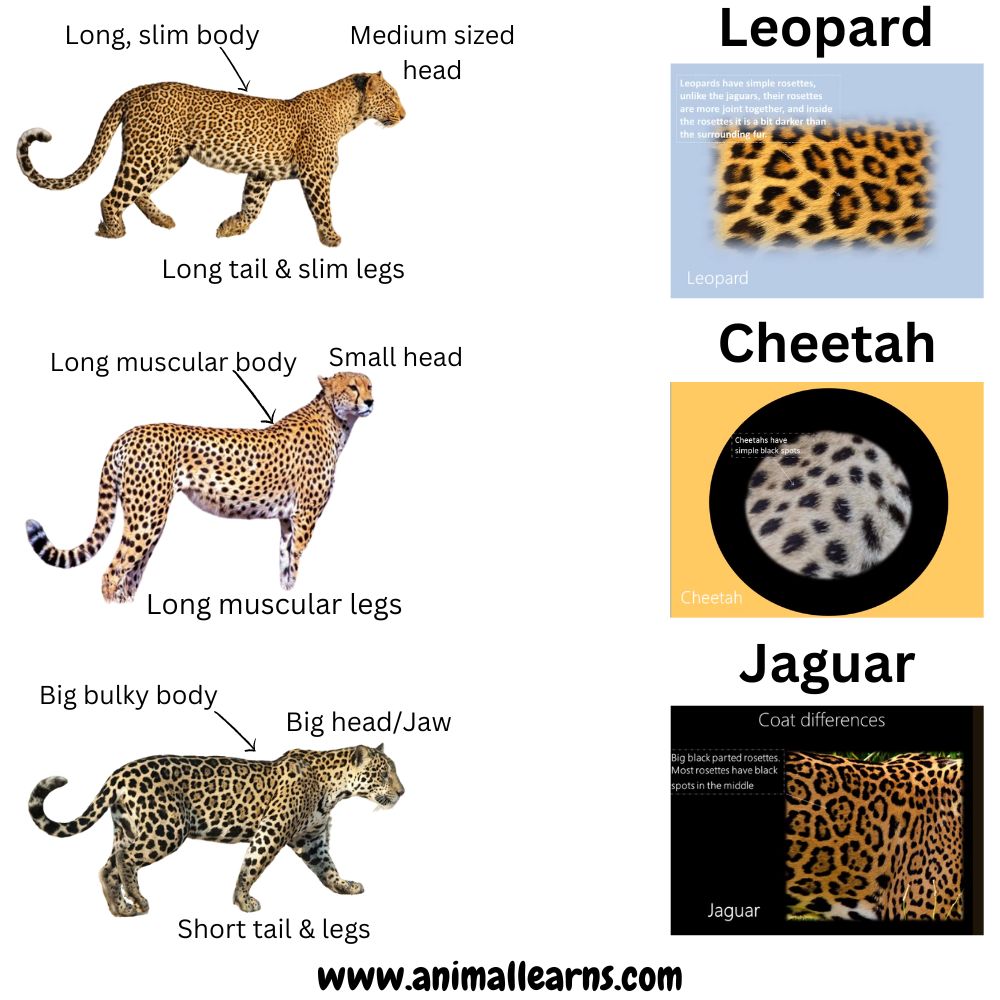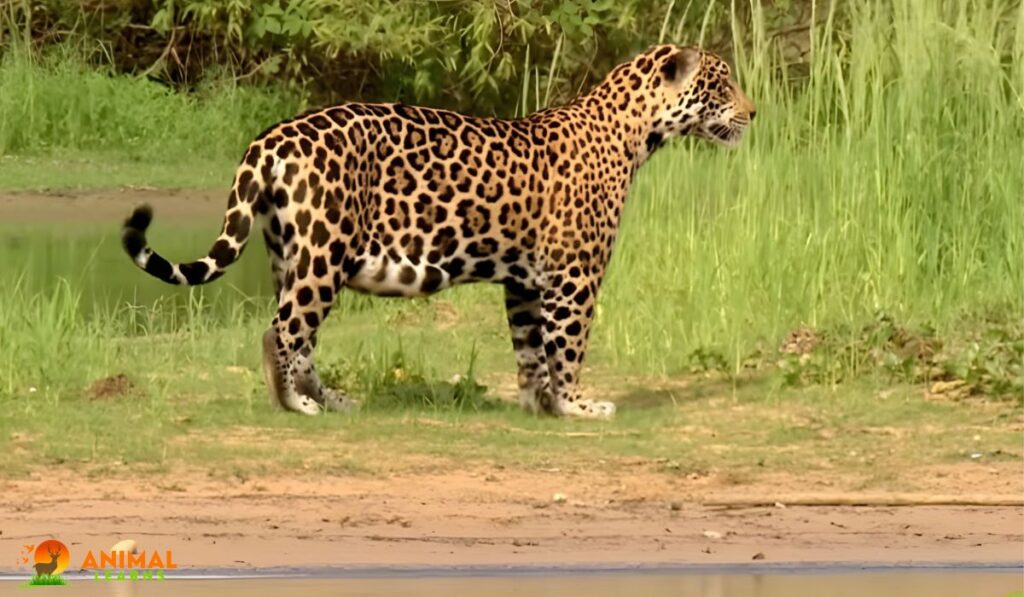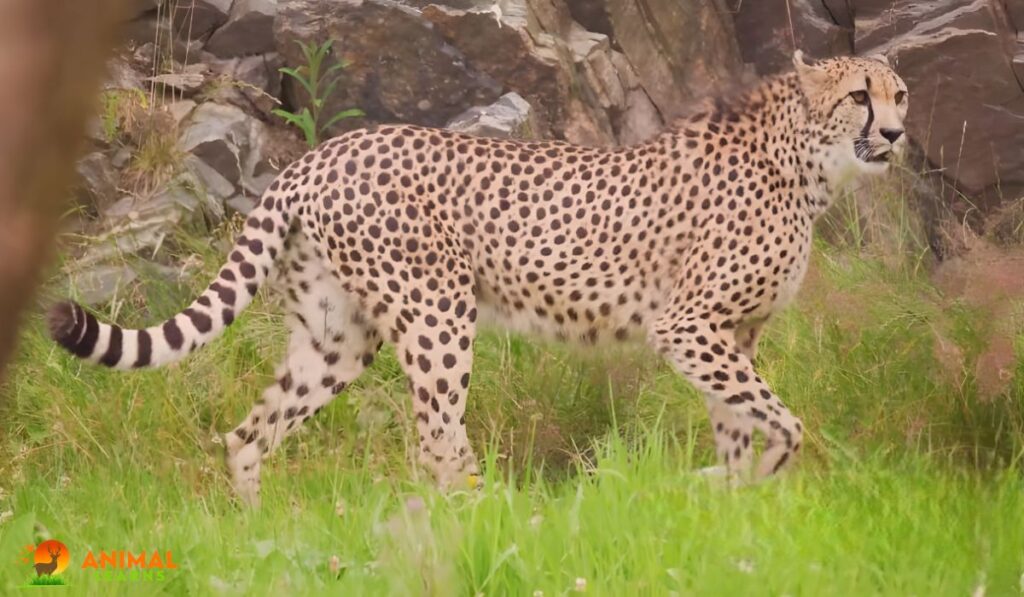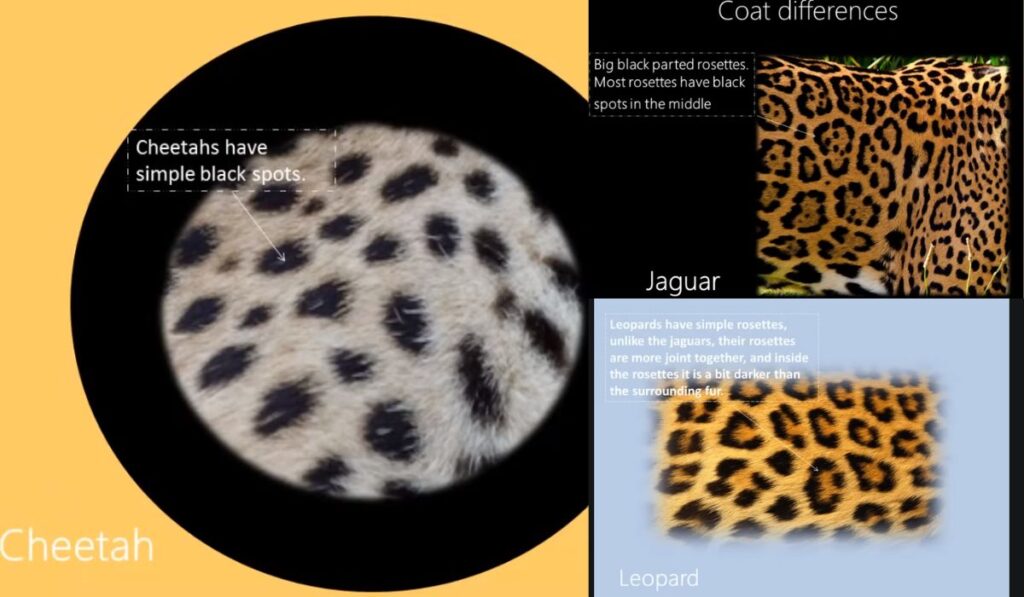Difference Between Leopard Vs Cheetah Vs Jaguar

When comparing the Leopard Vs Cheetah Vs Jaguar, It can be difficult to tells the difference between Leopards, Cheetah and Jaguars. They can sometime be seen as the same animal.
Here are the main differences between these three big cats.
Let me introduce you to one of my biggest obsessions when I was a kid. In fact, if I’m being honest, it’s still one of my biggest obsessions. I’ve always been particularly fond of wildcats. I used to read every single article I could find about them, closely observe every single picture on Google, and watch every single YouTube video about them.
As a result, my brain is filled with knowledge about them that I’ll likely never forget. The other day, I was talking to my mom about how much I love these animals, and I discovered that most people can’t tell the difference between these magnificent animals. So, I was inspired to write an article talking about how to tell the difference between jaguars, leopards, and cheetahs.
First, some background information about these animals:
Jaguars
Contents

Jaguars, which were probably my favorite animal when I was a kid, are a large feline species native to the Americas. In fact, they’re the only living members of the genus Panthera that are native to the Americas.
For some extra background information, the genus Panthera is a genus that includes lions, tigers, jaguars, leopards, and snow leopards. Anyway, they’re known for their very strong bite and their unique way of killing prey—biting directly into the skull to deliver a fatal blow to the brain. Jaguars prefer eating animals with lots of flesh, such as capybaras and giant anteaters.
In addition to that, they prefer ambushing their prey rather than chasing down prey. They are also solitary animals with the exception of female jaguars and their cubs. Jaguars are least likely to attack humans and will only attack when cornered or wounded. Unfortunately, they are threatened by habitat loss and poachers.
Leopards

Next, leopards. Leopards are also part of the genus Panthera, and they live in sub-Saharan Africa, some parts of West and Central Asia, the Indian subcontinent, and East and Southeast Asia. Leopards are known for being able to inhabit a large variety of habitats, ranging from rainforests to montane areas.
Like jaguars, leopards are solitary animals; however, female leopards interact with their cubs. Leopards generally prefer medium-sized prey, such as bushbucks and impalas. They’re also known for hunting predators like jackals and even cheetahs. Leopards usually hunt at night and tend to ambush their prey.
Leopards have lots of enemies, such as hyenas, lions, and tigers. They usually try to avoid humans, but they are known to eat humans. Healthy leopards don’t prefer hunting humans; however, sick and elderly leopards will hunt humans. Leopards are also threatened by habitat loss, and their conservation status is vulnerable.
Cheetahs

And finally, cheetahs. Cheetahs are obviously known for being the fastest land animal, with a range of 50 to 80 miles per hour. They are a large feline native to Africa and central Iran. They’re the only living member of the Acinonyx genus. They’re found in habitats like savannas, mountainous areas, and deserts. Cheetahs are usually solitary, but male cheetahs aren’t known to fight for territory.
Female cheetahs aren’t very social either. Some cheetahs are known to form coalitions; however, they generally prey on small to medium-sized prey like gazelles. Cheetahs generally hunt during the day so that they can avoid lions. They generally stalk their prey and then start chasing their prey.
After hunting, they usually drag the prey near a bush or under a tree and keep watch for other prey or for any predators that could try and steal the kill. Cheetahs are known for being pretty gentle towards humans, and as a result, can be tamed easily. Unfortunately, they are threatened by habitat loss, poaching, and susceptibility to diseases.
Differences Between Leopard Vs Cheetah Vs Jaguar

Coat color
The habitat of a leopard determines the color of its coat. For instance, to blend in with their environment, snow leopards are gray in color and inhabit frigid, wintry climates. Leopards inhabiting dry areas have a pale yellow tint, whilst those found in jungles have a considerably deeper golden hue. The tip of a leopard’s tail is noticeably white, in case you were wondering.
Leopards have a white belly with black patches, as do jaguars and cheetahs. The inner legs of these large cats are no different. Despite having pale yellow fur, both jaguars and cheetahs may easily be distinguished from one another because to the patterns on their coats.
Coat Pattern

The cheetah stands out from the other two animals when you contrast its hairy coat with that of the leopard and the jaguar. The others lack the black facial stripes that cheetahs have, which extend from the corner of their eye to their chin. Moreover, a cheetah’s spots are pure black, but a leopard’s and a jaguar’s have rosettes.
With the exception of their head, legs, and paws, which have solid spots, jaguars’ rosettes are big and contain one or more center dots. The rosettes of leopards are smaller and lack center dots.
Height and build

Leopard Vs Cheetah Vs Jaguar becomes a captivating journey, unveiling not only their distinct physical characteristics but also the unique behaviors and habitats that set each magnificent feline apart.
Leopards are smaller than jaguars, and their heads are smaller and more angular. In addition to that, their rosettes are smaller and denser, and they don’t have central spots.
Though it may appear a bit plumper than the other species, the leopard is an extremely skilled predator. They have a shoulder measurement of 22.4 to 27.6 inches (57–70 cm), and they are frequently seen napping high in trees.
Cheetahs are much smaller than jaguars and leopards. Their heads are rounded but are smaller. They also have black tear marks on their face.
Of our three wild cats, the cheetah is the biggest, with a shoulder length that ranges from 26 to 37 inches (67 to 94 cm). A cheetah’s body is exceedingly lean. They can quickly reverse direction while sprinting thanks to their long, slender tail and long, thin legs.
Jaguars are much larger than cheetahs and leopards and have a large rounded head. They have rosettes that are very large compared to leopards, and each rosette has a central spot.
The jaguar is somewhat smaller than the cheetah, standing 26 to 29.5 inches (67 to 75 cm) tall at the shoulder. Jaguars have short legs and a large, square-looking skull that complement their compact, powerful bodies. When it comes to swimming, jaguars are far better than their African cat companions.
Attack and Defense
The cheetah approaches the unwary jaguar stealthily using its small frame. The cheetah uses its hooked thumb claw to trip the larger cat while the jaguar, alerted to its presence, leaps forward. When the jaguar falters, the cheetah uses its signature neck-grabbing grip to start smothering it. However, the leopard dives in before the jaguar faints.
The leopard slices the cheetah with his claws because he makes use of both his explosive charge and the element of surprise. The cheetah has been defeated by the leopard once more. However, despite having somewhat greater muscle, the jaguar is still dangerous.
The leopard is several feet distant from the jaguar as it jumps. The powerful jaguar leaps on the other cat and skillfully bites its throat after positioning itself in a secure spot. Jaguars bite with a force of about 1,500 pounds per square inch, demonstrating their incredibly strong jaw muscles.
Intelligence and Survival Skills
The three rivals are really smart. They survive, nonetheless, in quite different ways. For example, cheetahs are not proficient tree climbers as leopards and jaguars are. All three of the wild cats are also proficient swimmers, although leopards are the most comfortable in the water.
The cheetah is trying to recover at the start of the round. But the jaguar and leopard climb a tree to escape the onslaught. The cheetah can’t keep up.
The cheetah observes from the ground, gathering strength, while the cat fight rages on in the trees. The leopard uses its exceptional swimming abilities to escape by jumping into the river below, just when it appears as though the jaguar may have the upper hand.
Who Would Win in a Fight Between a Leopard vs. Cheetah vs. Jaguar?

The jaguar prevails! Compared to cheetahs and leopards, jaguars are larger and more powerful. They also feel at ease bringing down big targets. But the jaguar would not be able to easily prevail over these two in a battle.
A cheetah’s quickness and capacity to stumble victims would make things interesting. Not to mention the leopard’s skill at ambush and its razor-sharp claws, you can see how bad things may go. The jaguar would emerge victorious in what would be the ultimate cat vs cat fight!
When we compare Leopard Vs Cheetah Vs Jaguar, we see that they’re all special in their own ways. They act differently, look different, and live in different places. Each of these big cats is important for keeping our world diverse and interesting.












